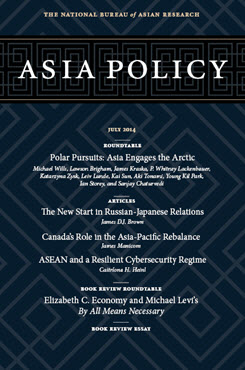Asian States in U.S. Arctic Policy
Perceptions and Prospects
This essay is part of the roundtable “Polar Pursuits: Asia Engages the Arctic.”
In May 2013, five Asian states—China, South Korea, Japan, India, and Singapore—were admitted as observers to the Arctic Council. [1] Generally, the United States views the admission of these nations into the work of the council as a positive development that deepens international cooperation on a key global challenge. [2] The admission of observer states represents an appropriate progression of the strength and role of the council as an international institution, and it also recognizes the global importance of the Arctic region. [3] The U.S. position takes a distinctly American approach to internationalism that reflects a union of liberal values and transparency with a concern for protecting the United States’ national interest in the political stability and environmental security of the Arctic.
The aim of U.S. grand strategy is to develop a broadly inclusive and integrated international system in which all nations share certain rights and responsibilities. [4] By recognizing the interests of Asian states in the Arctic region and welcoming them into the Arctic Council, the United States seeks to broaden the number of stakeholders positioned to share benefits and assume responsibilities in the region, provide a positive example for other regional and functional organizations, and underscore U.S. regional leadership.
The United States’ Interests in the Arctic
The United States understands that it is an Arctic nation “with broad and fundamental interests” in the region. [5] Six major issues steer U.S. Arctic policy, which is focused on securing a region that is “peaceful, stable, and free of conflict”: (1) national security, (2) environmental protection, (3) resource conservation, (4) accommodation of the interests of indigenous populations, (5) scientific research, and (6) international cooperation. [6] These interests are pursued along three major lines of effort: (1) advancement of U.S. national security interests, (2) pursuit of environmental protection and resource conservation, and (3) development of stronger bilateral and multilateral cooperation. [7] These three pillars of U.S. Arctic policy are likely to persist—and indeed become even more acute—driven both by changes in the region’s natural environment and by increased human activity.
National security requirements in the region revolve around preservation of the freedom of navigation and overflight in the Arctic Ocean—specifically, traditional rights and freedoms to engage in commercial trade, conduct scientific research, and operate ships and aircraft of the armed forces in, over, and above the ocean. This approach to maritime security has deep historical roots. Since its inception, the United States has regarded freedom of the seas as a core component of a liberal international order. As a new republic, for example, the United States fought its first war as an independent country against France—the 1798–1800 Quasi-War—to protect freedom of navigation for U.S. merchant ships. During the early 1800s, the country also battled Barbary pirates and went to war with England over this issue. A century later, the United States was drawn into two world wars in large part over the issue of freedom of navigation and Germany’s strategy of unrestricted submarine warfare. Similarly, the Atlantic alliance that connected the United States to its European allies during the Cold War depended on their common interest in freedom of navigation. Thus, it is no mistake to suggest that preserving maritime mobility in the Arctic Ocean is yet another expression of this cardinal tenet of U.S. grand strategy.
To ensure freedom of navigation in the Arctic, the United States is on a course to tailor Arctic infrastructure and management, including navigational aids, vessel tracking, ship routing, traffic separation schemes, waterway management regimes, and ports and reception facilities, to the evolving human and commercial activity. [8] Space, air, and sea-surface capabilities will be further enhanced as Arctic conditions change….
Endnotes
[1] U.S. Department of State, “Joint Communique of the Arctic Countries on the Establishment of the Arctic Council,” September 19, 1996, available at http://1997-2001.state.gov/www/global/oes/oceans/arctic_council.html.
[2] White House, National Security Strategy (Washington, D.C., 2010), 47-50, http://www.whitehouse.gov/sites/default/files/rss_viewer/national_security_strategy.pdf.
[3] This analysis does not present an official U.S. position but rather is based on the author’s interpretation of U.S. motives and interests, which are informed by media accounts, official publications of the United States and other Arctic and non-Arctic countries, statements by international organizations, and discussions with policymakers.
[4] White House, National Security Strategy, 1-2.
[6] White House, National Strategy for the Arctic Region (Washington, May 2013), 2-3, http://www.whitehouse.gov/sites/default/files/docs/nat_arctic_strategy.pdf.
About Asia Policy
Asia Policy is a peer-reviewed scholarly journal presenting policy-relevant academic research on the Asia-Pacific that draws clear and concise conclusions useful to today’s policymakers. Asia Policy is published quarterly in January, April, July, and October and accepts submissions on a rolling basis. Learn more


